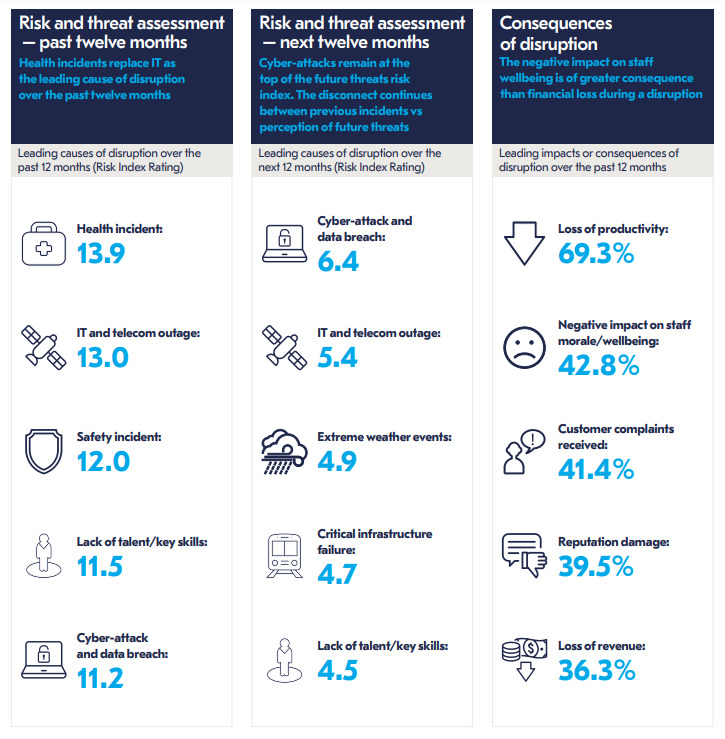If the recent pandemic has taught us anything, it is that disaster can strike anyone, anytime, and in an absolutely unexpected way.
Knowing how to create a business continuity plan (BCP) for your business can help you survive through the storm and bounce back successfully.
? Read Crisis Management 101: How to Save Your Business When a Crisis Strikes
This BCI Horizon Scan Report gives a good overview of the risks businesses are facing presently and the consequences of disruption.

We have seen over and over that small and medium businesses that ignore having a crisis management plan go out of business when disaster strikes.
On the other hand, according to Agility’s State of Business Continuity report, 80% of businesses surveyed were able to mitigate the pandemic impact because they had a business continuity plan.
Realizing its importance, 91% of businesses have updated their BCP in the past 12 months.
If you are a business owner, you must be convinced by now that BCP is essential for the survival of your business.
But how do you create a business continuity plan to stay operational when you face a threat? How do you recover fast and with minimal loss?
Here are 5 tested and proven steps you can follow to create a successful business continuity plan.
Let’s get started.
What is a Business Continuity Plan?
Do disasters or threats give advance notice? Most of the time, no.
And even when we get a prior warning, we have very little time to react.
From a business perspective, these are dreadful situations. And that’s where a business continuity plan comes into the picture.
A business continuity plan refers to a detailed outline of procedures and instructions a business will follow to maintain essential functions during a major disruption. It provides a guideline on how to recover faster after a disaster has happened.
Whether you are a large-scale manufacturer or a tech startup developing tools like lead generation software and so on, having a BCP is crucial for your survival.
The disruption could come in any form, a natural calamity, a public health emergency, a technical or mechanical emergency, or a cyber attack.
Irrespective of the threat, a business continuity plan should essentially cover three major areas.
- Disaster preparedness
- Emergency response
- Recovery plan
A BCP provides comprehensive protection for your business assets and personnel during and after a disaster strikes.
Read Four Crisis Management Steps to Take to Stop a Disaster
5 Steps to Create a Robust Business Continuity Plan
Realizing how critical a BCP is for your business, you would definitely want to know how to create a business continuity plan to secure your future.
Here is a 5-step guide on how to create a strong business continuity plan for 2023 and beyond.
1. Build Your Business Continuity Management Team

The first step in how to create a good business continuity plan is to make your top management or key stakeholders realize the value of BCP.
Once they are on board, put together a core BCP management team that will head the entire department.
The team should consist of:
- Diverse professionals from critical business areas like finance, IT, product development, HR, marketing, communications, and others. Use their data-driven inputs to understand the risks and develop solutions.
- A dynamic leader who will drive your BCP team.
Your employees shoul contribute to creating your BCP and also you can get your stakeholders and suppliers involved to ensure critical functions don’t come to a halt.
Read Crisis Management Plan: How to Keep Your Business Afloat?
2. Conduct Risk Assessment and Business Impact Analysis
The second step in how to create a business continuity plan is analysis.
Risk Assessment (RA) and Business Impact Analysis (BIA) are both essential parts of this phase.

Risk Assessment is all about identifying the internal and external threats to your critical business processes and ranking them based on the severity of the threat.
When carrying out the Risk Assessment, be sure to use the right tools to measure your brand health.
Business Impact Analysis is all about understanding how each of these risks you have identified will impact your business and what should be your recovery approach.
For successful RA and BIA, your team should identify metrics specific to your business to be measured at different levels.
To effectively analyze the risks and their impact, follow these methods.
- Prepare a risk analysis and business impact questionnaire to be filled by different department heads
- Analyze the responses and draw main observations
- Identify key resources and establish the dependencies within the organization and outside
- Document and map a detailed plan to mitigate the challenge and recover as successfully as possible
3. Develop and Implement Recovery Strategies
Now we move on to the next step. Based on the above analysis, your core team can create a detailed business continuity plan.
This is how to create it:
- Prepare a detailed list of procedures and guidelines that your emergency response team should follow. It is good to establish an emergency response team for each critical department right from production, research, HR, security, digital marketing, sales, and finance
- If your facility needs to be shut down for a while due to damage, you should plan for a way to meet the demand for your products or services
- Come up with a remote working policy for your employees in case of a natural disaster or a public health emergency
- Strategize a data backup and recovery plan in case of a malicious attack
- Invest in good business continuity management tools such as business spending control tools, cloud data backup tools, etc.
- Buy adequate insurance to cover all your critical assets
4. Communicate and Train
We have covered three major steps of how to create a business continuity plan. But this plan can only be executed successfully if your entire team is prepared and equipped to do so.
Once your business continuity plan is finished, it is important to communicate the same to your employees. This is where an internal communications specialist with a degree in marketing communications would play an important role. They’ll help convey this message well.
They should know everything about the possible risks, the critical functions, and the expected response.
Each team needs to get adequate training on how to execute the business continuity plan for their department. Use premiere pro templates to create engaging training videos, use scenario-based techniques, and apply other effective training methods.
While you incorporate the BCA into your company policy, it is also necessary to equip your staff with various tools that can help them work efficiently on regular days and when a disaster strikes.
Along with this, a crisis communication plan should also be set in place to inform your employees, stakeholders, clients, and authorities concerned when a crisis occurs.
Read Crisis Management Plan Examples: The Best & The Worst
5. Test and Upgrade
Once you have gained in-depth knowledge on how to create a business continuity plan, you’re sure to come up with a solid plan.
But how do you know if it’s effective or not?
It brings us to the last and equally important step in how to create a good business continuity plan. Test the BCP in all possible ways and validate it.
The testing should involve all the teams concerned. You should even consider involving key stakeholders, suppliers, and customer care representatives to participate in the testing exercise.
Once you analyze the results of the exercise, identify the areas you need to improve and upgrade your plan according.
When you send reminder emails to your clients and stakeholders, you can keep them informed about the BCP upgrades too.
Testing and upgrading is something you need to be doing at regular intervals to ensure your business continuity plan stays relevant and effective.
Are You Ready to Create a Solid BCP for Your Business?
It would be safe to conclude that every business should have a strong business continuity plan to safeguard their business from risks of different kinds.
The BCP for each industry and business type may slightly vary. That’s why your core team should understand how to create a business continuity plan and tailor it for your business.
If you don’t have a BCP for your business yet, take it up as a priority and create a resilient plan.
Use the above 5 steps as the framework and get started right away. The future of your business depends on it.
Gaurav Sharma is the founder and CEO of Attrock, a results-driven digital marketing company. Grew an agency from 5-figure to 7-figure revenue in just two years | 10X leads | 2.8X conversions | 300K organic monthly traffic. He also contributes to top publications like HuffPost, Adweek, Business 2 Community, TechCrunch, and more.



